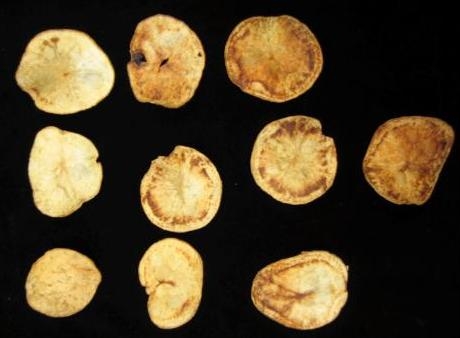The research team, which rescued the potato chip industry from major losses, is the “Zebra Chip Research Team.” It has just won the Integrated Pest Management Team Award from the Entomological Foundation, a national organization that aims to educate young people about science through insects. The foundation recognized the team for its research and extension efforts that have had a dramatic effect on the potato industry.
John Trumble, a distinguished professor in the Department of Entomology at the University of California, Riverside, is a member of the Zebra Chip Research Team. He explained that by the time the team formed in 2008, a new pathogen had devastated the potato industry by spreading zebra chip disease, causing losses in the millions of dollars annually (see Q&A below).
“Indeed, many growers were on the verge of leaving the industry entirely,” he said. “When pesticide use in the fields increased dramatically, with unsatisfactory results, more economic losses followed.”
The Zebra Chip Research Team developed new techniques to identify the pathogen, allowing researchers to document local, regional, and national movements of the potato psyllid (Bactericera cockerelli) spreading zebra chip disease. The researchers determined both within-plant and within-field movements of the psyllid and the zebra chip pathogen, and developed special sampling programs that enabled potato growers to choose the level of risk they were willing to accept.
The sampling programs accurately determined the efficacy of pesticides and the benefit of available biological control agents. They also documented a variety of alternatives to unsustainable pesticide use. Through websites, effective outreach practices, and grower and scientific meetings, the Zebra Chip Research Team promoted a sustainable integrated program that today allows the industry to continue to produce potatoes while making a profit and minimizing potential negative effects for the environment.Besides Trumble, the following researchers are members of the Zebra Chip Research Team: Charlie Rush, an epidemiologist at Texas A&M University; Neil Gudmestad, a plant pathologist at North Dakota State University; Gerhard Bester of Frito Lay; Casey Butler of Syngenta Crop Protection; Joe Munyaneza, an entomologist, and Jim Crosslin, a plant pathologist, at USDA-Agricultural Research Service, Yakima, Wash.; Jon Goolsby, an entomologist at USDA-Agricultural Research Service, Edinburgh, Texas.; Don Henne, a horticultural scientist at Texas Agrilife Research, Weslaco; and Fekede Workneh, a plant pathologist at Texas Agrilife Research, Bushland.
Congratulations to them all for their work on zebra chip disease and the recognition they received from the Entomological Foundation!
Q&A with Trumble:Where in the country is the disease affecting potatoes?
Arizona, California, Colorado, Kansas, Nebraska, Nevada, Oregon, New Mexico, Texas, and Washington State. Problems have now been reported throughout California, including Riverside County, Kern County and Ventura County. We find it in our experimental plantings in Orange County.
What kind of economic loss has zebra chip disease caused?
In the 2004-06 growing seasons, Texas growers estimated losses at over $25 million. Many growers during and since then have abandoned fields, with Texas reporting about a 20% reduction in planting. Guatemala, Honduras and New Zealand have reported over 80% of plants infested and losses of nearly all marketable size tubers. Dollar losses in California have not been estimated, but growers throughout the USA dramatically increased pesticide applications, which greatly increased production costs. Much of the Team's efforts were designed to determine how to economically control the pest. We did this by minimizing or eliminating use of the class one (highly toxic) pesticides, developing control strategies with low environmental impact and high economic return for the investment, and increasing use of beneficial insects.


